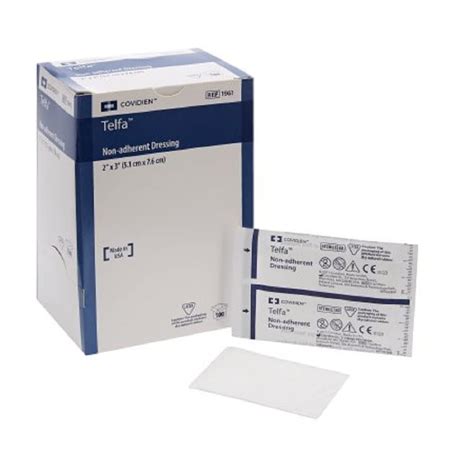Telfa pads, also known as Telfa non-adherent dressing pads, are a type of wound care product used to protect and promote the healing of wounds, cuts, and abrasions. These pads are made from a non-adherent, porous material that allows for the free flow of fluids and gases while preventing the dressing from sticking to the wound. This unique property reduces the risk of further injury or trauma to the wound when the dressing is changed, making Telfa pads an essential item in first aid kits and medical facilities.
The history of Telfa pads dates back to the mid-20th century when the first non-adherent dressings were developed. Since then, Telfa pads have become a staple in wound care, widely used by medical professionals and individuals for treating minor to moderate wounds. The pads are available in various sizes, making them suitable for use on different parts of the body. Their versatility, combined with their effectiveness in promoting a clean and dry environment conducive to healing, has solidified their place in modern wound management.
Key Points
- Telfa pads are made from a non-adherent material to prevent sticking to wounds.
- They are used for protecting and promoting the healing of wounds, cuts, and abrasions.
- Telfa pads are available in various sizes for use on different body parts.
- They allow for the free flow of fluids and gases, promoting a clean and dry healing environment.
- Telfa pads are an essential component of first aid kits and are widely used in medical facilities.
Composition and Functionality of Telfa Pads

Telfa pads are composed of a unique, non-adherent material that is gentle on the skin and does not stick to the wound, reducing the risk of further injury or discomfort during dressing changes. This material is porous, allowing for the exchange of gases and the absorption of fluids, which helps to keep the wound dry and promote healing. The pads are also breathable, which aids in preventing the buildup of bacteria and other pathogens that could lead to infection.
Uses and Applications of Telfa Pads
Telfa pads are versatile and can be used for a variety of wound types, including cuts, abrasions, burns, and post-surgical wounds. They are particularly useful for wounds that are sensitive or at risk of further irritation, as they provide a protective barrier without adhering to the wound site. Additionally, Telfa pads can be used under other dressings or bandages to prevent them from sticking to the wound, making them a valuable component of comprehensive wound care.
| Wound Type | Telfa Pad Size | Usage Frequency |
|---|---|---|
| Minor cuts and scrapes | Small (2x2 inches) | As needed, typically 1-2 times a day |
| Moderate wounds and abrasions | Medium (4x4 inches) | Every 24-48 hours, or as directed by a healthcare provider |
| Larger wounds or post-surgical sites | Large (6x6 inches or larger) | As directed by a healthcare provider, typically every 24-72 hours |

Best Practices for Using Telfa Pads

Using Telfa pads effectively requires understanding their application and the principles of good wound care. Before applying a Telfa pad, the wound should be cleaned and dried to promote an environment conducive to healing. The pad should be placed gently over the wound, ensuring it is centered and evenly spread. If additional dressings or bandages are to be applied, they should be secured in a way that does not put excessive pressure on the wound or the Telfa pad.
Regular monitoring of the wound and the Telfa pad is essential. The pad should be changed as needed, usually when it becomes saturated with fluid or as part of a scheduled dressing change. Proper disposal of used Telfa pads and any other dressing materials is also important to maintain hygiene and prevent the spread of infection.
Clinical Evidence and Recommendations
Clinical evidence supports the use of non-adherent dressings like Telfa pads in wound care, highlighting their effectiveness in promoting healing, reducing the risk of infection, and minimizing discomfort during dressing changes. Professional organizations and healthcare guidelines often recommend the use of such dressings as part of comprehensive wound management strategies. However, it’s essential to follow specific recommendations from healthcare providers, as the needs of each wound and patient can vary.
What are Telfa pads used for?
+Telfa pads are used for protecting and promoting the healing of wounds, cuts, and abrasions. They are made from a non-adherent material that prevents the dressing from sticking to the wound, reducing further injury or discomfort.
How often should Telfa pads be changed?
+The frequency of changing Telfa pads depends on the type and severity of the wound, as well as the amount of fluid or drainage from the wound. Generally, they should be changed when saturated with fluid or as part of a scheduled dressing change, usually every 24-48 hours, or as directed by a healthcare provider.
Can Telfa pads be used under other dressings or bandages?
+Yes, Telfa pads can be used under other dressings or bandages to prevent them from sticking to the wound, making them a valuable component of comprehensive wound care. This is particularly useful for sensitive wounds or when using dressings that might adhere to the wound site.
In conclusion, Telfa pads are a vital tool in wound care, offering a non-adherent, breathable, and protective barrier that promotes healing and minimizes the risk of further injury or infection. By understanding their composition, functionality, and best practices for use, individuals and healthcare professionals can effectively utilize Telfa pads as part of a comprehensive approach to wound management.



